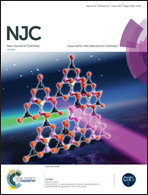Synthesis and magnetic and cytotoxic properties of copper(ii) halide complexes with 1,2,4-triazolo[1,5-a] benzimidazoles†
Abstract
Coordination compounds based on copper(II) halides with 4H-1,2,4-triazolo[1,5-a]benzimidazole (L1), 3-methyl-1,2,4-triazolo[1,5-a]benzimidazole (L2), and 4-methyl-1,2,4-triazolo[1,5-a]benzimidazole (L3) with the compositions [Cu(L1)2(Hal)2]·nH2O (Hal = Cl−, n = 0.5 (I) Br−, n = 1 (II)); [Cu(L2)2Cl2] (III), [Cu(L3)2Cl2] (IV) and [Cu(L3)2Br2(H2O)]·2H2O (V) were synthesized. The compounds were characterized using X-ray diffraction, UV-Vis spectroscopy (diffuse reflectance spectra), infrared spectroscopy, and static magnetic susceptibility measurements. By means of X-ray diffraction structural analysis, crystal structures were determined for the [Cu(L3)2(Hal)2(H2O)]·2H2O complexes, where Hal = Cl− (IVa) or Br− (V). Cytotoxic effects of the complexes and ligands on the cell line Hep-2 were then studied, and we found that the copper(II) complex with ligands L1–L3 leads to a considerable enhancement of cytotoxicity.
![Graphical abstract: Synthesis and magnetic and cytotoxic properties of copper(ii) halide complexes with 1,2,4-triazolo[1,5-a] benzimidazoles](/en/Image/Get?imageInfo.ImageType=GA&imageInfo.ImageIdentifier.ManuscriptID=C7NJ00533D&imageInfo.ImageIdentifier.Year=2017)


 Please wait while we load your content...
Please wait while we load your content...